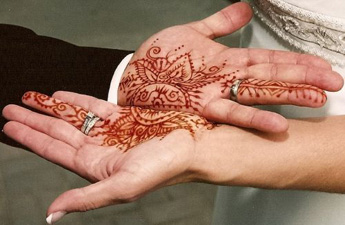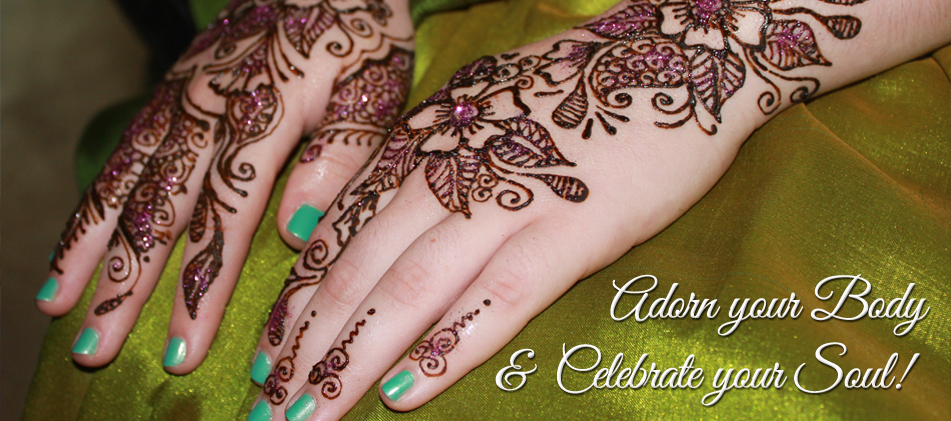What is Henna?
Henna, scientific name Lawsonia inermis, is a plant grown in countries with hot climates; including India, Pakistan, Yemen, Morocco, Egypt etc. The leaves of the henna plant are crushed and milled into a fine powder, then mixed with natural ingredients to make henna paste. This henna paste is used to create beautiful designs on the body, and has been used as such for centuries all over the world. This art form is called Mehndi.
How does Henna work?
Henna body art, also known as henna tattoos or Mehndi, is temporary. Henna paste is applied on the skin with an applicator (Wardah uses a cone rolled from cellophane sheets) and left on for 4-8 hours. Henna stains the top few layers of the skin cells, and once the paste is removed you will have a beautiful henna design on your body that will last for approximately 1-3 weeks depending on a number of factors.
Which part of the body does Henna stain best?
Henna stain will be a light/bright orange initially when you remove the paste and will gradually darken to a beautiful burgundy/brown color over the next 48-72 hours.
Natural henna works best on hands, wrists, arms, legs, ankles and feet. Henna stains are the darkest on the palms of the hands, and soles of the feet where the skin is the thickest. Henna designs can be created on any part of the body, including shoulders and back, but the stain may not be as dark as on the hands and feet.
What Makes Henna Stain Dark
1. Time Duration: Natural henna MUST be kept on the skin for as long as possible. A minimum of 4 hours is suggested, while it is recommended to keep the henna paste on overnight (8-10 hrs) for a really rich stain. The longer the henna paste is kept on the skin, the more time it has to release its dye and go deeper into the layers of skin.
2. Body temperature: Henna and heat are really good friends! If your hands are usually icy cold, your henna stain may not turn out dark. Warming your hands over the stove or in front of the fireplace, while the henna paste is still on is a good idea. The palms are generally warmer than the rest of the body which is one of the many reasons why your henna stain will be the darkest on the palms.
3. Exfoliation: Since henna stains the layers of skin, if you have exfoliated right before having henna applied, then henna may not have enough layers to be absorbed into and might result in a stain that is not optimum. Therefore it is recommended to do waxing, shaving, massaging, etc. a day or two before getting your henna done. Your body sheds skin cells continuously, some people have a faster rate of exfoliation than others. Two people can have a henna design done on the same part of body, follow the same after-care, and still one persons stain may fade faster than the others.
4. Body Part: It is just not possible to get a henna stain to be as dark on the arm as on the palm. The reason is the difference in the skin composition. The palms of hands and soles of feet have considerably thicker skin (more layers of skin cells) than any other part of the body. That is why henna has more layers to dye and you will see that natural henna can go a deep mahogany or cherry black on palms and soles. Henna stains on the feet will last longer than on the hands. Also, the skin of the face/neck may not take the henna stain well as usually facial skin is oily, which may hinder in the absorption of henna dye into the skin layers.
5. Water Contact: Keeping fresh henna stain away from water for the first 24 hrs is very important. Contact with water will hinder the stain from reaching its peak. The more you wash dishes, wash your hands, the faster your skin cells will exfoliate, hence taking the henna stain along with them. Chlorine in pool water will have an adverse effect on your henna stain. Avoid swimming if you want longer lasting stains. If your henna stain was not very dark initially and had not stained deep into the skin, then it will also fade away very quickly. Once your henna stain is deep and dark after 48-72 hours of application, it depends on you how well you take care of it to make it last longer. To have a beautiful dark henna stain, and expect it to stay that way for the next month is just not possible. We cannot stop our skin from exfoliating! So, generally when henna artists apply henna, they give a time-frame of 1 to 3 weeks that your henna stain will last. By 3 weeks, your henna stain will either be gone, or become

Henna Stain Progression
Find out how it really stains!
How long does Henna stains last?
Since henna stains the top few layers of skin cells, the design starts to fade away with exfoliation, and may go away completely in 2-3 weeks, leaving behind clear skin for a fresh new design! That is the beauty of henna... you will never be stuck with one design for the rest of your life like permanent tattoos!

